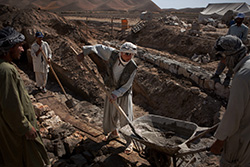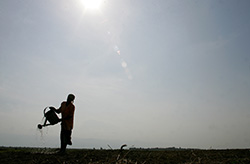Investments in land and water

UN projections indicate that the world population could increase by more than 2 billion people by 2050, to 9.15 billion. For a population that size to be free from hunger, global food production must either increase by 70 percent, or policies and actions must be put in place to change consumption patterns, create more balanced diets, reduce food wastage, produce more food near where it is consumed, and improve food distribution.
Investment in land and water is an important means for boosting agricultural productivity, but such investment is decreasing or stagnating, driven largely by a perception of declining rates of return compared with investments in other sectors. Recent surges in food prices and a decrease in food security, however, show the limits of such short-sighted strategies. The return on capital invested in agriculture rarely matches that in industry and urban services because it fails to capture the multiplier and social benefits of rural investment, beyond the direct impacts on food security.

The benefits of investment in land and water are much wider than boosting productivity, improving farmers’ incomes, generating on-farm employment, increasing food security and lowering food prices (thus reducing poverty). They also have significant positive effects in the non-farm economy, for example by stimulating the consumption of goods produced by small-scale enterprises and generating significant non-farm earnings for the poor.
Governments, authorities and development practitioners thus face a paradox: they have agreed to strive to achieve development goals that require increased production with diminishing per capita resources, without the concomitant investment to do so. FAO projects that, based on long-term estimates of food demand, the investment required in primary agriculture and its downstream industries in developing countries could amount to US$9.2 trillion in the period 2007–2050, with 18.5 percent of the total allocated to expanding and improving irrigation and about 3 percent allocated to land development, soil conservation and flood control.

It is not only financial resources that are needed: policy alignment, public and private institutional capacity, and an enabling environment that can attract and implement greatly increased funding in land and water are prerequisites for effective investment. It is particularly important that countries are clear about their investment needs in land and water to address food security and poverty alleviation and promote growth. An investment framework is necessary to quantify and prioritize overall financing needs to meet specific policy targets. This does not preclude the formulation of detailed projects, but it does suggest that individual projects are identified and evaluated within an overall investment framework, along with more programmatic demand-led investments that may have shorter cycles. Such frameworks can also set the basis for reciprocation between governments and donors, ensuring that investment envelopes are mutually credible and eligible.
It is vital that support for land and water is not reduced, especially in times of crisis. Only a healthy agriculture sector, combined with a growing non-farm economy and effective safety nets and social protection programmes, will be sufficient to eradicate food insecurity and poverty.
